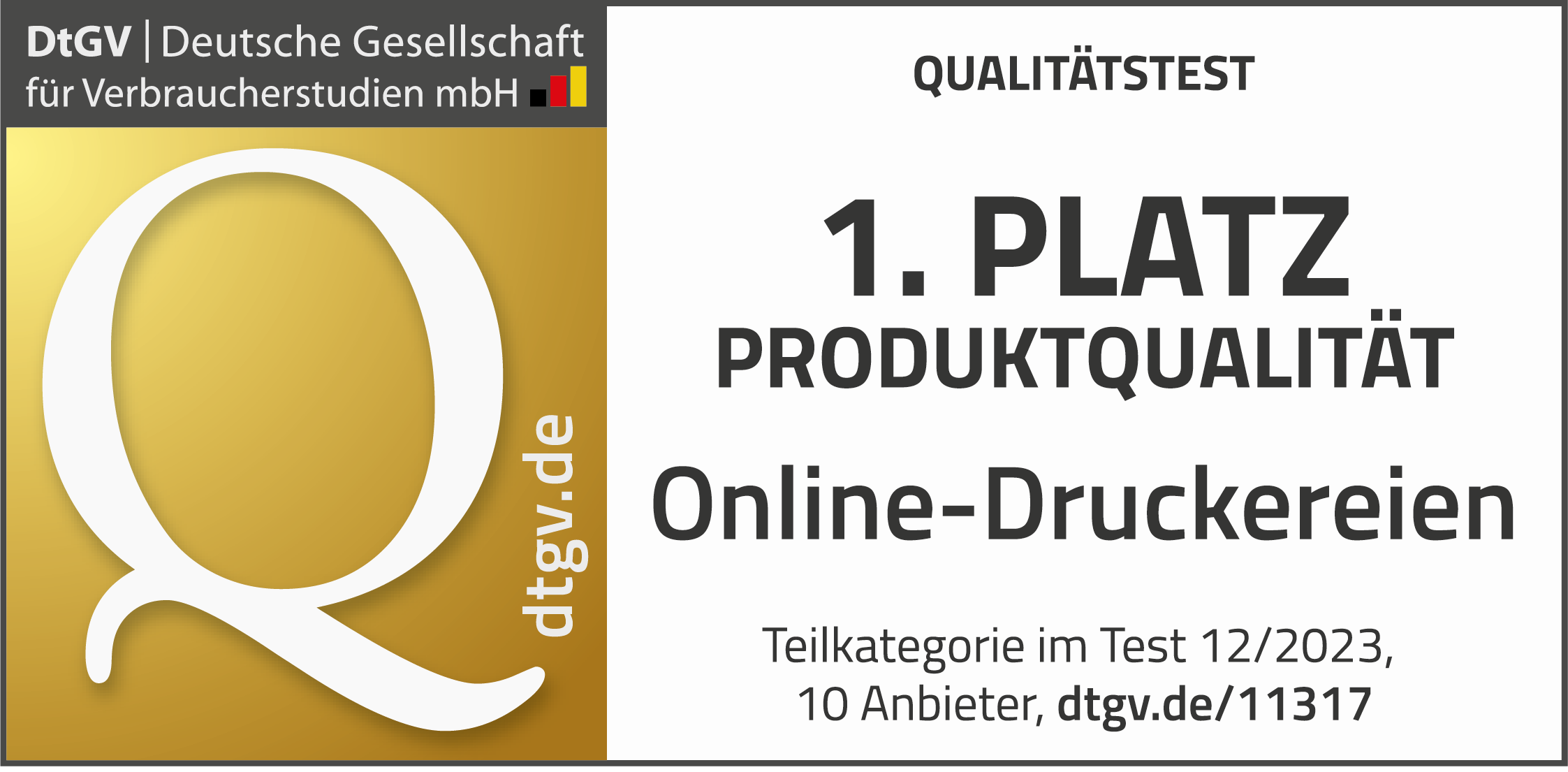Info-Center
Colours
How to prepare your layouts for ordering:
Colours
General information
Variations & tolerances
We produce according to the Process standard in digital and offset printing. Even with correct production within the permissible tolerances, noticeable colour variations may occur. The Process standard permissible tolerance allows ∆E ≙ 5 per channel. This means that visually a deviation of 5–10 % ink coverage may be noticeable.
We produce according to the Process standard in digital and offset printing. Even with correct production within the permissible tolerances, noticeable colour variations may occur. The Process standard permissible tolerance allows ∆E ≙ 5 per channel. This means that visually a deviation of 5–10 % ink coverage may be noticeable.
Attention! For combination printing, we offer HKS and PANTONE colours only from the current colour charts "HKS Klassik K/N" and "Pantone Solid Coated/Uncoated".
Colour profiles
Please use the following colour profiles:
Coated papers: PSOcoated_v3.icc
Uncoated papers: PSOuncoated_v3_FOGRA52.icc
Please note: You can find our current profiles in the download area. If your data contains deviating profiles, these are taken into account and converted according to the selected material.
Ink coverage
The maximum ink coverage results from the sum of individual colour channels (C+M+Y+K). For example, red: C: 0 % + M: 100 % + Y: 100 % + K: 0 % = 200 %.
Maximum:
| Coated papers: | max. 300 % |
| Uncoated papers: | max. 300 % |
Minimum:
| Per colour channel: | min. 5 % |
Please note: At an ink coverage of less than 5 % (per channel), we can no longer ensure printing. Colours are either no longer perceptible or are not printed.
Special colours (Pantone/HKS)
In combination printing, we offer all HKS and Pantone colours from the current colour charts "HKS Klassik K/N" and "Pantone Solid Coated/Uncoated". If you require colours that are not part of the current special colour charts, we are happy to implement these in individual printing.
We recommend that you do not set special colours to overprinting, since they will otherwise mix with the process colours (CMYK) underneath. In combination printing we cannot influence the order in which the colours are printed.
If special colours are desired, they must be ordered in the shop:
If no special colour was requested, the print file must not contain a special colour. Please convert special colours that weren’t ordered into process colours (CMYK).
Of course, special colours that are created for finishing or further processing must be included in the file.
Use of neon colours:
When using neon colours from the Pantone or HKS system, please note that, for example, a combination with UV coating will significantly reduce the luminance of the colour. In order to obtain the optimum colour intensity, you should also not mix neon colours with other colours by overprinting, but always set to cut out in the file.
Creating spot colors in the graphic program
To correctly create a spot color in a graphics program such as Adobe Illustrator, InDesign or CorelDRAW, a new color field must be created and defined as a spot color. The exact name of the desired spot color, for example Pantone 072U for dark blue or light green, should be used. Once the color has been defined, it can be applied to all desired design elements. When exporting the print file, make sure that the correct format is selected, for example PDF/X-4, and that the spot colors are not inadvertently converted to CMYK. It is important that the color designations match the specifications exactly so that the colors are processed correctly.
Information on the color fastness of Pantone colors
The lightfastness of Pantone colors varies depending on the shade and is crucial for outdoor poster advertising (poster paper). Each Pantone color has its own lightfastness, which is determined by its formula and pigments. In general, darker colors and blue tones have higher lightfastness than yellow and red tones. The Wool Scale rates lightfastness from 1 (low fastness) to 8 (high fastness):
Neon colors often have a lightfastness rating of 1 and are therefore not suitable for outdoor use. For projects that will be used outdoors, we recommend choosing colors with a higher wool scale rating to ensure better durability.
| WS 1: | Very poor lightfastness – visible fading after just a few days outdoors. |
| WS 3-4: | Mediocre lightfastness – suitable for outdoor use for a few months. |
| WS 7-8: | Very good lightfastness – lasts for several years. |
Neon colors often have a lightfastness rating of 1 and are therefore not suitable for outdoor use. For projects that will be used outdoors, we recommend choosing colors with a higher wool scale rating to ensure better durability.
Metallic colours
Both black (5-100 % K) as well as coloured elements can only be printed cleanly on gold and silver if they are not set to "overprinting". Otherwise the metallic effect will be lost or CMYK elements will lose colour intensity and become indistinct and poorly discernible.
Metallic colours in combination with:
| UV coating: | Changes the effect, metallic effect is lost |
| CMYK objects: | Always set to knockout |
| Black text < 8 pt: | Is automatically overprinted; if this is not desired, please convert the font to paths and set them to knockout (100 % black [K]) |
Gold and silver:
For our standard gold in collective printing (5/5-color + gold), we use Pantone 871 C for coated papers such as picture printing. Or Pantone 871 U for uncoated papers.
Our standard silver in collective printing (5/5-color + silver) is printed with Pantone 877 C or U.
Please note: In combination printing, we cannot influence the order in which the colours are printed.
Registration colour
The registration colour named "All" is for print marks. It consists of 100 % each of the colour separations cyan, magenta, yellow and black plus the special colours used. Due to the excessive ink coverage, the registration colour must not be used within the layout.
Attention!
Vector objects with registration color
Vector objects are always converted to 100 % K. If additional image objects with registration color are on the same page, there will be visible differences in the black display of these objects (see "Image objects with registration color").
Image objects with registration color
Image objects with registration colour are reduced in colour application to our prescribed standard (300 or 320 % colour application). If there are also vector objects with registration color on the same page, there will be visible differences in the black display of these objects (see "Vector objects with registration color").
Overprinting CMYK white
White text and design elements (C: 0 % M: 0 % Y: 0 % K: 0 %) that have been assigned the "overprint" attribute are not visible after printing and must therefore always be set to knockout.
Note: To maintain the visibility of white front and objects, you must always set to knockout. Elements to which white or paper is assigned as a color are usually automatically omitted. However, if objects with other colours are subsequently used with 0 % ink coverage or if the elements themselves are assigned the attribute "overprint", they are no longer visible after printing. You can check this with the overprint preview of the layout program or Adobe Acrobat.
Opaque white
Substrates with a transparent background can be underprinted in white (e.g. transparent stickers). For silver-metallic paper, opaque white can be ordered as an additional option.
Elements that are to be underprinted in white must be duplicated and set up with the overprinting special colour named weiss and with the following parameters:
| Set up as: | Vectors or pixels |
| Colour for visualization: | 100 % cyan |
| Hue: | 100 % |
| Swatch name: | weiss |
| Colour type: | Full-tone colour/special colour/spot colour |
| Overprinting: | Overprint surface and/or contour |
Attention! Please do not try to simulate the overprinting behaviour of special colours through transparency effects (multiply, overlay etc.).
Please note:
When processing the print data, the opaque white is automatically set to overprinting! If there are supposed to be objects underneath the opaque white areas, they must additionally be created underneath the opaque white and should also be correspondingly coloured.
In case of e.g. white objects on a coloured background, the opaque white must not be set to knockout. An object in CMYK white (C: 0 % M: 0 % Y: 0% K: 0%) must in fact be created underneath the opaque white. Place all white elements in the top layer or at the top position in your file and set them to overprint.
Tip: Our 90 µm transparent gloss film is ideal for glass surfaces. For vibrant colors, we recommend using opaque white as a fifth offset or digital printing ink as a primer. In offset and digital printing, pure white is not completely opaque.
Newsletter
Erfahren Sie von Neuigkeiten immer als Erstes.
Abonnieren Sie unseren Newsletter für Informationen und exklusive Angebote.


